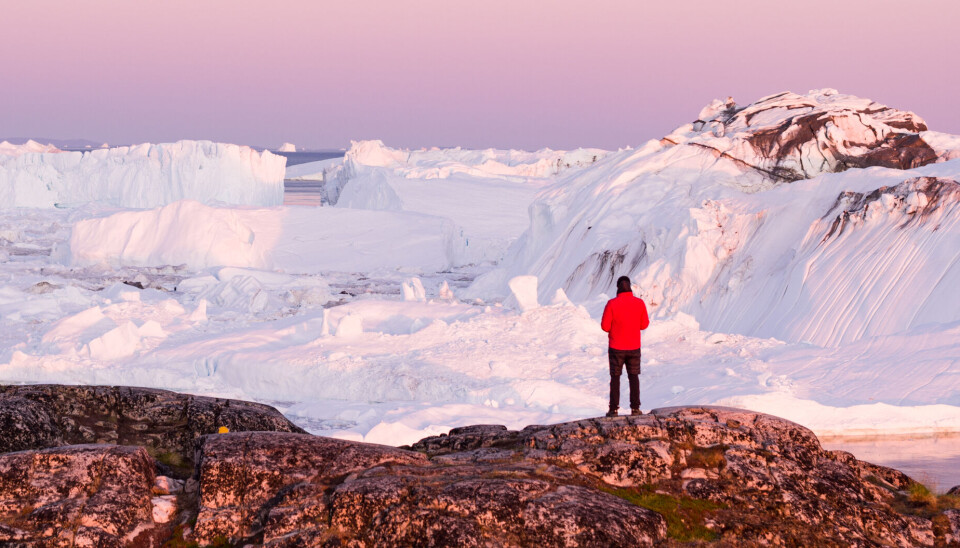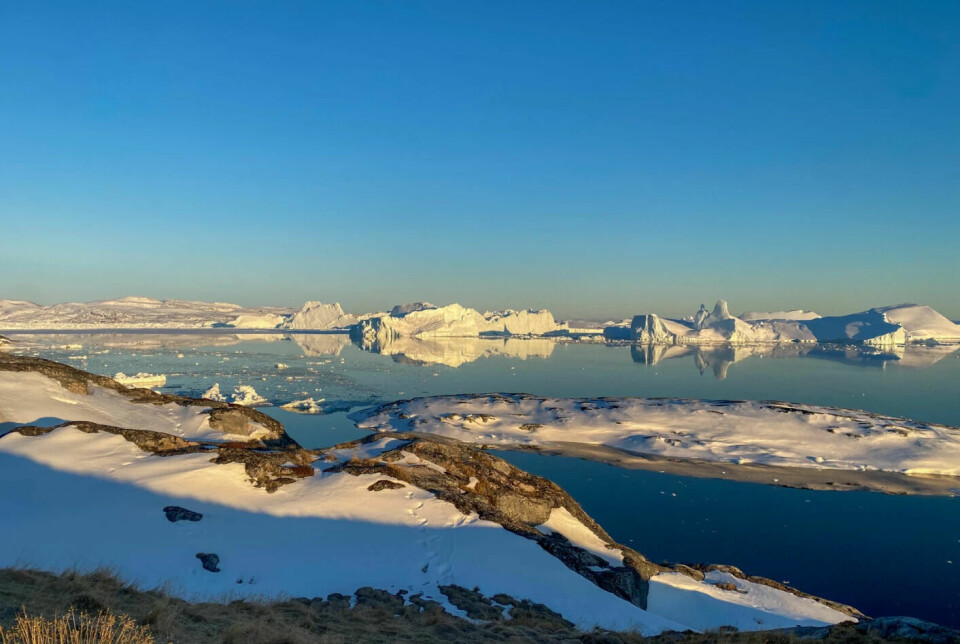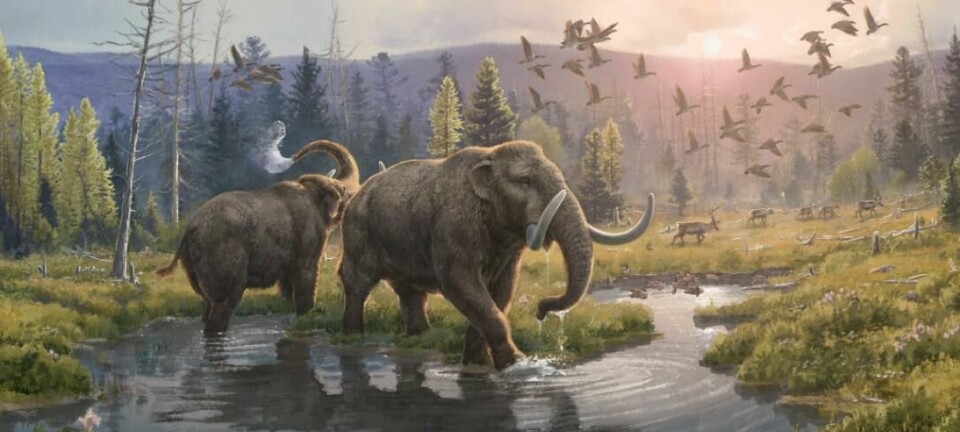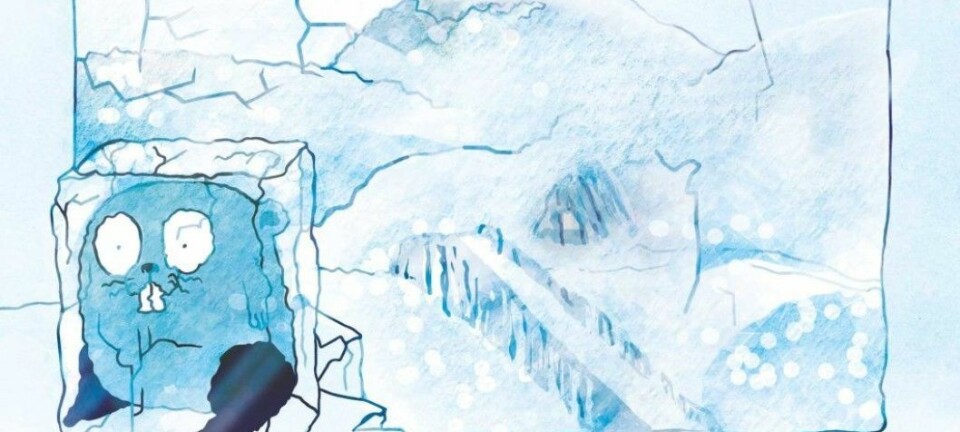
How much heat can the Greenland ice sheet really handle?
Even if the tipping point is passed, the ice can still grow back. But that does not necessarily help much in practice, a researcher points out.
One of the things climate researchers work on is investigating tipping points. When does a system tip over into a new state?
The Greenland ice sheet exists because it is cold enough for the ice to remain. Greenland has previously come close to being ice-free (link in Norwegian). At what temperature is it actually not cold enough anymore?
In a new study, researchers have found that the tipping point lies between 1.7 and 2.3 degrees above the global average in pre-industrial times.
If the temperature rises above this and stays there, Greenland will begin its journey towards becoming ice-free, according to the study. If everything were to melt, it would correspond to a rise in sea level of more than seven metres.
Fortunately, it will take a very long time for the entire ice sheet to melt.
How long will it take?
Most viewed
No content
If the temperature stays just a little above the threshold, it could take several tens of thousands of years for all the ice to melt. This is a hypothetical scenario where the global average temperature stays just above the tipping point for that long.
If the temperature is maintained at three to four degrees above the pre-industrial level, it will take thousands to tens of thousands of years. It depends somewhat on the model used.
Nils Bochow, who participated in the new study and is a doctoral candidate at UiT The Arctic University of Norway, explains this.
Above the tipping point
In the new study, Bochow and colleagues have examined what happens if the temperature temporarily exceeds the tipping point.
Will the Greenland ice sheet continue to melt uncontrollably? Or will the ice begin to grow back if the temperature is sufficiently reduced?
The results have been published in the journal Nature.
“We have seen in earlier studies with simple models that we can exceed the critical threshold of a system for a short period without there being a transition to another state,” Bochow tells sciencenorway.no.
“We wanted to investigate how much we can exceed this critical threshold without committing to a complete loss of the Greenland ice sheet.”

Possible to reverse
Researchers used two different ice models to find answers.
“What we find is that we can exceed the threshold for quite some time without actually committing ourselves to a complete loss of the ice,” Bochow says.
The maximum time the temperature can be above the tipping point is several thousand years if we stay just above the limit. The time window becomes shorter the more we exceed the critical threshold.
Within this period, the ice could begin to grow back if it becomes a bit colder.
“Along the way, however, we would lose significant portions of the Greenland ice sheet, leading to a multi-metre increase in sea levels. Additionally, even if temperatures were later reduced, the ice sheet might not return to its current size,” he says.
Consequences for coastal populations
Kerim Hestnes Nisancioglu is professor of climate dynamics at the University of Bergen and has reviewed the new study.
He tells sciencenorway.no that the researchers have investigated fundamental questions.
“As a researcher, I find it super exciting,” he says. “What is the tipping point for the Greenland ice sheet? Will the ice come back, how long will it take, and how long can we exceed two degrees?”
Nisancioglu says that the study shows that over hundreds to thousands of years, it is possible to get the glacial ice back if it becomes colder. The main focus of concern is what will happen in the upcoming two hundred years.
How warm it becomes this century will affect how much meltwater comes from Greenland in the near future. It will also significantly impact what will happen in Antarctica.
In the worst-case scenario, the sea level could rise by more than one metre within this century.
“Even if the Greenland ice sheet were to grow back in a few hundred, maybe thousands of years from now, it would be too late. The lives of people along the coast in large parts of the world would be affected regardless, and that is completely unacceptable,” Nisancioglu says.
Nisancioglu stresses that the study should not be used as a justification for exceeding the two-degree climate goal.
What if it becomes 3 degrees warmer?
Nils Bochow provides some examples of what the results showed.
Let's say we end up with a temperature increase of three degrees by 2100.
If the temperature is lowered again to well below the tipping point within the next 100 years, Greenland's contribution to sea-level rise will be around 10 centimetres, according to the study.
If the temperature takes a thousand years to decrease again, the resulting sea level rise would be approximately 25 to 30 centimetres.
Over the span of 10,000 years, sea levels could rise by 1.5 to 2 metres.
In an alternative scenario where the temperature increases by four degrees Celsius by the year 2100, reducing the temperature substantially over a span of 500 years would contribute to a 20 to 30 centimetre rise in sea levels from Greenland, based on model predictions.
How much the temperature needs to be lowered to reverse the development varies.
If we manage to lower the temperature after 'just' a few hundred years, it might suffice to bring it down to slightly below the tipping point. To get all the ice back, we might have to go even lower.

The sea level in 2100
Does the research provide any insights on the anticipated sea level rise over the next 100 years?
“For the near future, the results for sea-level rise are consistent with previous studies,” Bochow says.
Researchers in this study have focused on the long-term perspective.
Sea-level rise is expected to be between 43 and 84 centimetres by 2100, according to a special report on oceans and ice from the UN’s climate panel. It depends on how large the greenhouse gas emissions will be.
The contribution from Greenland is expected to be between 4 and 12 centimetres in the same period.
Difficult and expensive
“The most interesting finding in this study is that the time window where we can exceed the tipping point for the Greenland ice sheet may be longer than we expected,” Bochow says.
“In a way, the study provides a more realistic picture of tipping points. In earlier studies where tipping points were exceeded, it is often assumed that no attempts are made to bring the temperature back down."
However, lowering the temperature again is not easy, Bochow adds.
“In practice, it could be very expensive and difficult, if it is even possible, to lower the temperature again if we cross the threshold. This is especially true for very high temperatures,” he says. “It will be easier to stay below the threshold from the start.”
Could be lower
The tipping point that the researchers found in the new study is consistent with previous research, according to Bochow.
“Quite a few studies have been done, and they show a similar threshold. The scientific consensus now is that the critical temperature lies between 1.5 and 3 degrees,” he says.
The question is up for discussion, says Kerim Hestnes Nisancioglu. It is possible that the tipping point is around 1.5 degrees, and it is not impossible that we are already at breaking point.
“The tipping point for the Greenland ice sheet is highly dependent on being able to represent the rapid ice streams,” he says.
This is not included in the models in the new study, nor in other models for Greenland in a long-term perspective.
“Ice streams are the moving parts of the ice. They drag a lot of ice out into the fjords and are affected by sea temperature and the climate along the coast of Greenland,” Nisancioglu says. “Unfortunately, it’s possible that the tipping point is lower because we are unable to represent the rapidly moving parts of the Greenland ice sheet. That worries me a bit.”
There are models for this process in certain areas. However, scaling it up from a fjord to the entire Greenland ice sheet has proved challenging. Efforts are underway to address this issue.
Precipitation
Another thing that the models in the new study do not fully capture is changes in winter precipitation, Nisancioglu points out.
According to Nisancioglu, summer temperatures are being considered, but variations in winter precipitation are not effectively incorporated.
In the new study, it was revealed that it is the southwestern part of Greenland that melts first.
"Precipitation is critical in determining which part of the Greenland ice sheet is most vulnerable. What we have demonstrated in several studies is that the northeastern part is more susceptible. It's an area where increased precipitation doesn't offset the loss, whereas in the south and east, there's compensation with higher precipitation," he says.
———
Translated by Alette Bjordal Gjellesvik.
Read the Norwegian version of this article on forskning.no
Reference:
Bochow et al. Overshooting the critical threshold for the Greenland ice sheet, Nature, 2023. DOI: 10.1038/s41586-023-06503-9



































